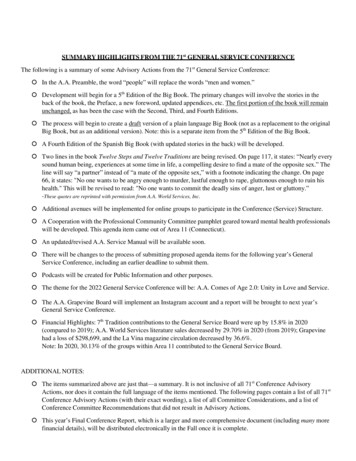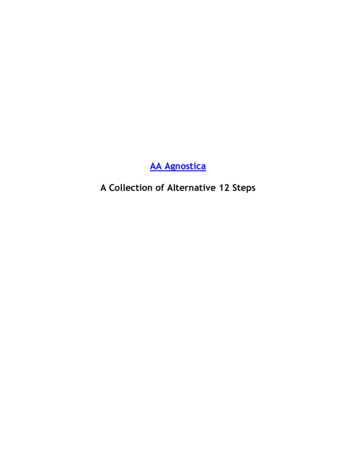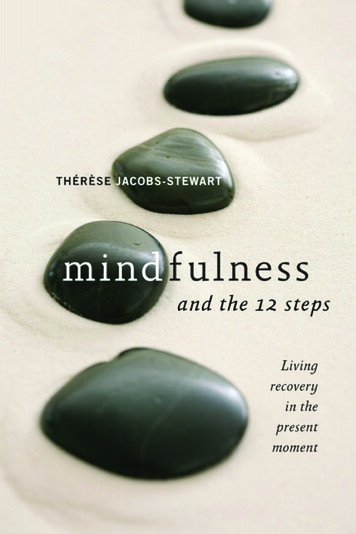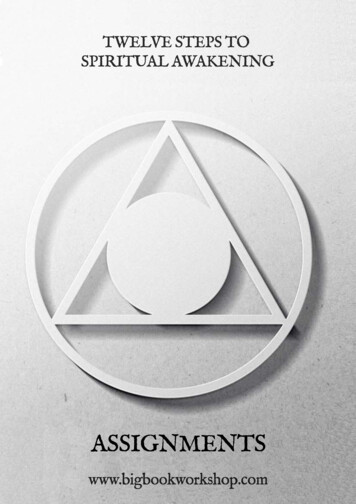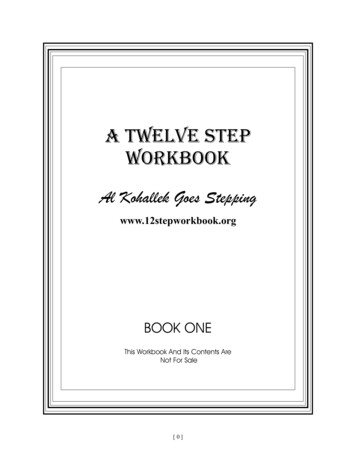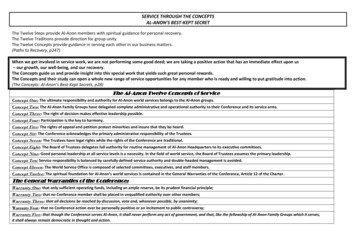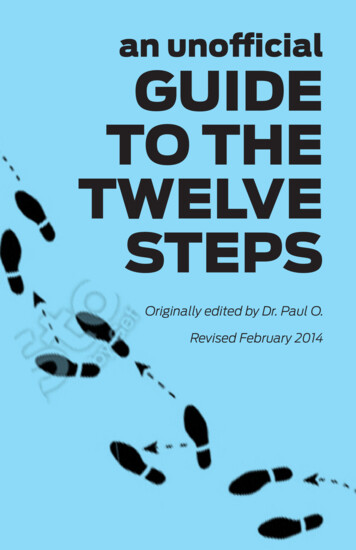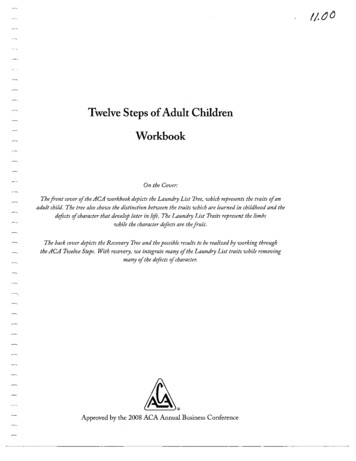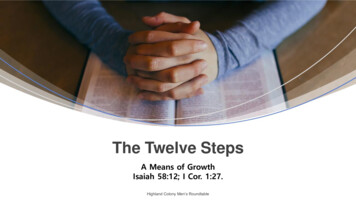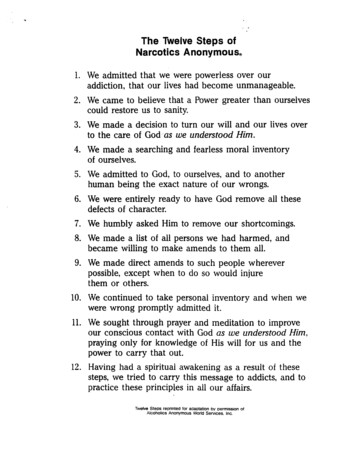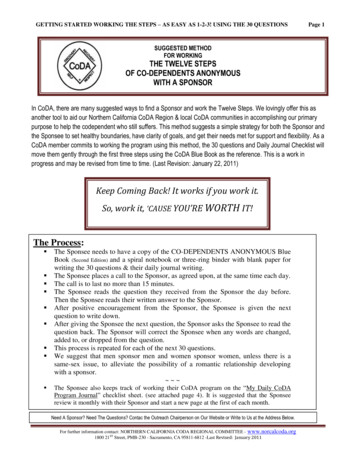
Transcription
GETTING STARTED WORKING THE STEPS – AS EASY AS 1-2-3! USING THE 30 QUESTIONSPage 1SUGGESTED METHODFOR WORKINGTHE TWELVE STEPSOF CO-DEPENDENTS ANONYMOUSWITH A SPONSORIn CoDA, there are many suggested ways to find a Sponsor and work the Twelve Steps. We lovingly offer this asanother tool to aid our Northern California CoDA Region & local CoDA communities in accomplishing our primarypurpose to help the codependent who still suffers. This method suggests a simple strategy for both the Sponsor andthe Sponsee to set healthy boundaries, have clarity of goals, and get their needs met for support and flexibility. As aCoDA member commits to working the program using this method, the 30 questions and Daily Journal Checklist willmove them gently through the first three steps using the CoDA Blue Book as the reference. This is a work inprogress and may be revised from time to time. (Last Revision: January 22, 2011)Keep Coming Back! It works if you work it.So, work it, ‘CAUSE YOU’RE WORTH IT!The Process: The Sponsee needs to have a copy of the CO-DEPENDENTS ANONYMOUS BlueBook (Second Edition) and a spiral notebook or three-ring binder with blank paper forwriting the 30 questions & their daily journal writing.The Sponsee places a call to the Sponsor, as agreed upon, at the same time each day.The call is to last no more than 15 minutes.The Sponsee reads the question they received from the Sponsor the day before.Then the Sponsee reads their written answer to the Sponsor.After positive encouragement from the Sponsor, the Sponsee is given the nextquestion to write down.After giving the Sponsee the next question, the Sponsor asks the Sponsee to read thequestion back. The Sponsor will correct the Sponsee when any words are changed,added to, or dropped from the question.This process is repeated for each of the next 30 questions.We suggest that men sponsor men and women sponsor women, unless there is asame-sex issue, to alleviate the possibility of a romantic relationship developingwith a sponsor. The Sponsee also keeps track of working their CoDA program on the “My Daily CoDAProgram Journal” checklist sheet. (see attached page 4). It is suggested that the Sponseereview it monthly with their Sponsor and start a new page at the first of each month.Need A Sponsor? Need The Questions? Contac the Outreach Chairperson on Our Website or Write to Us at the Address Below.For further information contact: NORTHERN CALIFORNIA CODA REGIONAL COMMITTEE - www.norcalcoda.org1800 21ST Street, PMB-230 - Sacramento, CA 95811-6812 -Last Revised: January 2011
GETTING STARTED WORKING THE STEPS – AS EASY AS 1-2-3! USING THE 30 QUESTIONSCommitmentBySponsor And Sponsee:Both Make a plan for when we dothe questions. Have a plan for working aquestion if Sponsor is notavailable. Agree that the Sponsee canend the 30-question process atany time. Agree that the Sponsor canstop being a Sponsor at anytime by verbal or writtennotification. Accept that the Sponsordoesn'tsponsorfamilymembers. Agree that anonymity andconfidentiality is practicedthroughout the 30-questionswork by both Sponsor &Sponsee. Develop the “Power of Five”to network with other CoDAmembers in recovery.Yes! I want to get a sponsor& work the Twelve Steps!Page 2Benefits Of The Process To Sponsee: Keeps Sponsee focused.Introduces the Sponsee to the first three stepsof recovery and gets Sponsee ready for thefourth step.Teaches the Sponsee that recovery takes timeand commitment every day, not just the onehour a week at his/her meeting.Teaches the Sponsee to use the tools ofrecovery such as the CoDA Blue Book,Twelve Steps & Traditions.Demonstrates using healthy interaction andcontinuous commitment to the process.Starts the process of opening up the Sponsee’sears to hearing what is said by others by beingable to test: “This is what I thought I heardyou say. Is this correct?”Gives Sponsee a format for being a Sponsor.Gives Sponsee thirty questions to use withhis/her Sponsees.At the end of the thirty questions, the Sponseeis ready to help another CoDA memberthrough the 30 questions with theunderstanding that if they don’t give away toanother person what they just got, they willlose it. “YOU’VE GOT TO GIVE IT AWAYTO KEEP IT!”What are Sponsors?Sponsors are people within the CoDA program who help guide us through the Twelve Step recoveryprocess. These people are recovering codependents whose personal recovery is their first priority. Theycontinue to learn how to live happy and fulfilling lives and are willing to share their experience, strengthand hope with us. They’ve usually walked the road of recovery longer than we have. They’re who we callfor help when we’re confused or overwhelmed. They can also be friends who work the program with us.Sponsors are able to remain objective and detached from feeling responsible for our happiness and recovery.They also refrain from behaving in abusive, critical, or controlling ways that can result in fixing, rescuing,acting as a therapist, sexual manipulation, or personal gain. Sponsors are role models for recovery, sourcesof loving support, and respectful of our anonymity and individual pace in working the program.For further information contact: NORTHERN CALIFORNIA CODA REGIONAL COMMITTEE - www.norcalcoda.org1800 21ST Street, PMB-230 - Sacramento, CA 95811-6812 -Last Revised: January 2011
GETTING STARTED WORKING THE STEPS – AS EASY AS 1-2-3! USING THE 30 QUESTIONSPage 3Sponsor’s Goals: To share with newcomers how I work my twelve step program.To share what I was like then and what I am like now.To share as a Twelve Step Guide, not as a friend or Higher Power.To share in “I” statements but live in “we” actions.To share tools I have added to my tool box and how I use these tools today.To practice healthy boundaries and be respectful of the Sponsee’s reality.Sponsee’s Goals: Accept that the Sponsor has high expectations of them as Sponsees. Some of the Sponsor’sexpectations are: Sponsee will be open to new ideas. Sponsee will share their new tools with others. Sponsee will do the work. Sponsee will call every day at agreed upon time. Sponsee will share only for 15 minutes each day. Sponsee will practice “H O W” – Honesty, Open-mindedness, & Willingness. Sponsee will leave the “Well But” and “Only If” excuses behind. Sponsee will be respectful of their and the Sponsor’s time and space. Sponsee will work no more than 30 minutes a day on the answer. Sponsee will allow the healing process to go as deeply as possible in the time allowed. Sponsee will trust the process knowing that if more healing work needs to be done on anyparticular issue, it will come up again. Remember: “Progress, Not Perfection” If we have agreement at this point, set a time for Sponsee’s first call to Sponsor to receive the firstquestion.The Benefit Of Sponsorship For Both The Sponsor And Sponsee: If we continue our step work with others and keep going back to meetings for help and support,we keep finding the tools and knowledge to become the best each of us can be. At the same time, we learn we are not alone in our recovery journey, nor are we unusual in anyway.Remember: Progress, Not Perfection!For further information contact: NORTHERN CALIFORNIA CODA REGIONAL COMMITTEE - www.norcalcoda.org1800 21ST Street, PMB-230 - Sacramento, CA 95811-6812 -Last Revised: January 2011
GETTING STARTED WORKING THE STEPS – AS EASY AS 1-2-3! USING THE 30 QUESTIONSFor further information contact: NORTHERN CALIFORNIA CODA REGIONAL COMMITTEE - www.norcalcoda.org1800 21ST Street, PMB-230 - Sacramento, CA 95811-6812 -Last Revised: January 2011Page 4
GETTING STARTED WORKING THE STEPS – AS EASY AS 1-2-3! USING THE 30 QUESTIONSPage 5THE THIRTY QUESTIONS FOR CoDA STEPS 1, 2 & 3(NOTE TO SPONSOR: PLEASE GIVE THESEQUESTIONS TO THE SPONSEE ONE AT ATIME WHEN THEY CALL AND ASK FOR THENEXT QUESTION)1.2.What is the first time you can remembercodependent related events happening inyour life? Have you lost any time, money,or energy due to unhealthy relationships?Write a brief history of your codependency.Discuss what help you have sought for thisproblem and your attempts to do this onyour own.Read Step One on pages 26-31 in theCoDA Blue Book. Discuss and reflect uponthe effect that codependency has had onyou over the years. Answer the 15questions on pages 28-29. Do you see thatyou have been involved in codependentrelationships? Do you truly see that you area codependent? Are you willing to change?3.Read Chapter One, pages 1-7. Recoverystarts with an honest self-evaluation.Reflect upon the following questions: Whatis codependence?Which f? What devastating losses havebrought you to CoDA? Discuss.4.Review Chapter One, pages 1-7. Reflect onhow codependent patterns have helped youin the past as survival mechanisms.However, survival is not living fully. InCoDA we are learning to live life. How hascodependency diminished your life? Why isit important to not push someone inrecovery until they are ready?5.telephone in CoDA? What is theimportance of anonymity? How are bothintertwined? Have you ever tried callingothers in CoDA and imagined yourtelephone weighed a “thousand pounds?”Discuss the principle of developing “thePower of Five” vs. becoming dependentupon only one or two other people inrecovery.6.Read Chapter One, pages 7-11.With thehelp of a loving Higher Power, the programof CoDA, and those who join us on thisjourney, each of us can experience the hopeof recovery. What are the promises of CoDependentsAnonymous?Whyiscodependence hard to recognize? Why is itimportant to replace denial & control withacceptance? What experience are youseeking in CoDA recovery?7.Read Chapter Two, pages 13-15. Answerthe five questions on page 13. Reflect whatis meant when it says, “When we attempt tocodependently control or manipulate otherswe turn ourselves into a Higher Power tomaintain our sense of safety and well-being.When we codependently avoid others, aswell as adapt or change our behaviors forothers, we give them, instead of our HigherPower, this control and strength.” Discuss.8.Review Chapter Two,Answer these questions:pages13-15. what is our “Spiritual Dilemma?” what attitudes are reflected when we usecontrol “to any degree?” what attitudes and feelings are reflectedwhen we use avoiding behaviors?What is the importance of using theFor further information contact: NORTHERN CALIFORNIA CODA REGIONAL COMMITTEE - www.norcalcoda.org1800 21ST Street, PMB-230 - Sacramento, CA 95811-6812 -Last Revised: DRAFT- January 2011
GETTING STARTED WORKING THE STEPS – AS EASY AS 1-2-3! USING THE 30 QUESTIONS9.Page 6 how does the position of “better than” or“less than” play a role in our selfcentered ways?B. How can feelings be resolved? Howcan you emotionally detach from those onwhom you compulsively rely? what does it mean, “Equality is Lost?”C. Does God create bad people? Is there aplace for forgiveness in recovery?Read Chapter Two, pages 16-18. Whatdrives your need to control and avoidothers? Did you ever experience abuse orneglect while you were growing up? Didthat affect your self-image? Describe.D. Read the section on page 99 “Do I Haveto Believe in God to Recover?”10. Read the sections “What is a ShameSpiral?” and “What Is Fear of Shame”pages 116-117. Discuss “fear of shame.”What behaviors do you commonly displaywhen you are afraid of someone hearingabout your mistakes? Notice a mistake thatyou made today. How do you feel about it?Reflect on this saying, “I MADE AMISTAKE, BUT I’M NOT A MISTAKE.”Discuss.11. Read both sections on pages 118-120.“What Are Physical And Aggressive FormsOf Abuse And Control?” & “What AreNon-Physical And Passive Forms Of AbuseAnd Control?” Which ones have youexperienced? Write your insights in yourjournal. Discuss.14. Read Step Two, pages 31-35. Are youwilling to entertain the possibility that thereis a power that can do for you what youcould not do for yourself? Insanity is doingthe same thing over and over againexpecting different results. Continuing toact in a self-destructive manner is insane,but nothing changes until you turn awayfrom your addictions and from the peoplewith whom you’re obsessed. Discuss andreflect upon the concept of insanity as itapplies to you in CoDA.15. Re-read Step Two, page 33. Make a list ofattributes of a Higher Power with whomyou would like to have a relationship. Whatdo you really want from your God?B. Read the section on pages 108-112“What are Boundaries?” Discuss.16. Re-read Step Two, pages 34-35. Write whatis meant when it says “We begin placingthis relationship first.”Discuss thestatement “your Higher Power does notaccomplish your recovery work for you;you must do your share.” What is yourpart? What needs to be done to develop andstrengthen your relationship with yourHigher Power?13. A. Read Chapter Two, pages 18-22.Discuss building your own concept of aHigher Power. Where have you put yourmisplaced faith in the past? Discusssurrender and letting go of your controllingand avoidance behaviors.17. Re-read Chapter Two, pages 20-22. Discussperfectionism and why it is an illusion. Tokeep perspective, why is it important toprioritize your relationships? Whatrelationship needs to come first? Whatrelationshipcomessecond?What12. A. Read the section “What Is TheDifference Between Being CodependentAnd Being Thoughtful?” on page 120.Write your insights in your journal.For further information contact: NORTHERN CALIFORNIA CODA REGIONAL COMMITTEE - www.norcalcoda.org1800 21ST Street, PMB-230 - Sacramento, CA 95811-6812 -Last Revised: DRAFT- January 2011
GETTING STARTED WORKING THE STEPS – AS EASY AS 1-2-3! USING THE 30 QUESTIONSrelationships come third?Discuss theanticipated miracles of recovery.18.A. Read Chapter Three introduction, “ASuggested Program of Recovery” on pages23-26. What does the program of CoDependents Anonymous consist of? Whywill a half-hearted attempt to work theSteps leave you feeling self-defeated?Discuss “Your journey thru the Steps maybe the most difficult work you everattempt.”B. Do you see working the Steps as anoverwhelming task? What are the rewardsof recovery? Are you willing to work theSteps daily as a part of your personalrecovery?19. A. Re-read Step Two, pages 31-35. Discussand reflect upon your childhood exposureto any religious concepts. On one side of atwo-column balance sheet list your negativefeelings and on the other side your positivefeelings as they relate to early religiousexperience. What conclusion do you reachwhen you reflect on the balance sheet?B. Read the section on page 100 “WhyDoesn't CoDA refer to God as He or She?”Discuss in your journal.20. Read Step Three, pages 35-39. Createanother balance sheet. On one side, list allthe reasons that you can believe in God.On the other side, list all your reasons fordisbelief.21. Re-read Step Three, pages 35-39. Why notgive God a chance where you have failed?What do you have to lose but your misery?Discuss why this program is not a “flash inthe pan.” Are you willing to ask God forhelp more than once?Page 722. Read the section, “How do I learn to trust?”on page 121. Did you learn early not totrust? Have you been overly trusting? Whatis appropriate trust? Why is it important tolearn to be able to trust ourselves and ourHigher Power first?23. Discuss the idea of calling a “HALT” whenyour life gets unmanageable. Do not allowyourself to get too h-hungry, a-angry, llonely, or t-tired.24. A. Get a box or container that is preciousto you. Put it in a special place and dedicateit as your “God Box.”B. Read the section “What is the Purpose ofPrayer and Meditation?” on page 100.Discuss in your journal.25. Read the section “Do I have to forgivethose who hurt me?” on page 121. Discusswhy “blaming” anyone is actually hurtful toyourself? However, forgiving too early canbe a quick fix. Therefore, what steps needto be done first before forgiveness can giveyou a lasting release from blaming? Whatare the benefits of forgiveness?26. Re-read Step Three, pages 35-39. Are youwilling to decide to trust God to care for allyou consider precious and important? Areyou willing to rely on your Higher Power toprovide you with peace, happiness, andwell-being? What energy will now beavailable when others are no longerresponsible for your happiness & wellbeing? Are you frightened to allow God totake care of you AND the other people inyour life? What are the crossroads whereyou are standing?For further information contact: NORTHERN CALIFORNIA CODA REGIONAL COMMITTEE - www.norcalcoda.org1800 21ST Street, PMB-230 - Sacramento, CA 95811-6812 -Last Revised: DRAFT- January 2011
GETTING STARTED WORKING THE STEPS – AS EASY AS 1-2-3! USING THE 30 QUESTIONS27. Re-read Step Three, page 37. Create aspecial place and time to sincerely completethis step. When you are ready, this prayermay be helpful: “God, I give to You all thatI am and all that I will be for Your healingand direction. Make new this day as Irelease all my worries and fears to youknowing that You are by my side. Pleasehelp me to open myself to Your love, toallow Your love to heal my wounds, andallow Your love to flow through me andfrom me to those around me. May Yourwill be done this day and always. Amen.”Make a sincere commitment to your HigherPower to turn your will and ALL your lifeover to God’s care. (May be completedwith your Sponsor or by yourself. Deepintention is the key to this step.)28. Re-read Step Three, on pages 37-39 startingat the second paragraph “We remember ”Every morning when you awake, renewyour decision to turn your will and your lifeover to the care of God as you understandGod. Make a commitment to activelystrengthen your relationship with your God.It isyour MOSTIMPORTANTrelationship. Trust in your Higher Power’shelp. Ask God for help and guidance. Doyour part. Strive for a life of balance. Lookfor strength and serenity as you grow intrust of God’s continuing presence and care.Discuss these ideas.Page 829. Discuss the saying, “Let Go, and Let God!”Is there any person, place, or situation withwhich you are upset or obsessing today?Each time you are uncomfortable andrecognize a lack of peace inside, rememberto work Step One, Step Two, and StepThree. Decide to turn the situation over tothe care of your loving Higher Power. Sayto yourself, “I am powerless over thisperson .” Write about the situation. Whatare you feeling? What are you needing?What is their part? What is your part?Prayerfully surrender the outcome to yourHigher Power and put it all in your GodBox.30. A. Reflect on your own personal surrender.Discuss and share at meetings yourexperience, strength, and hope from doingthe Steps & working the program this far.Celebrate that you have come this far! Areyou willing to commit to another 30questions to begin Step Four?B. From now on, while you keepprogressing with Step Four, everyday,practice the “maintenance steps” of CoDARecovery. When you awake in the morning,consciously work Step One, Step Two, andStep Three. Furthermore, before you retirefor the evening, practice Step Ten, StepEleven, and Step Twelve to the best of yourability. (Suggestion: you may wish to “takepersonal inventory” by comparing yourbehaviors each day to the RecoveryPatternsofCodependenceonwww.coda.org )For further information contact: NORTHERN CALIFORNIA CODA REGIONAL COMMITTEE - www.norcalcoda.org1800 21ST Street, PMB-230 - Sacramento, CA 95811-6812 -Last Revised: DRAFT- January 2011
GETTING STARTED WORKING THE STEPS – AS EASY AS 1-2-3! USING THE 30 QUESTIONSPage 9AnnouncementRequest for FeedbackTo:All CoDA SponsorsFrom: NorCal CoDA Regional CommitteeThank you for your interest in using the "30 Questions Sponsorship Tool” to sponsor other CoDAmembers. Sponsorship in CoDA is an honor and surely a challenge from our Higher Power to growin our own recovery! There are many ways to sponsor others in our program and eachsponsor/sponsee must decide what will work best for them. This is lovingly offered as anothertool.It is our hope that this sponsorship tool will be used at grassroots level and proven to beeffective for “CoDA as a Whole.” Therefore, as of October 2010, we began offering thissponsorship tool on our website to support our CoDA Region, plus any other CoDA members whoare interested.History: The “30 Questions Sponsorship Tool” for Steps One, Two & Three was originallydeveloped in 2009 coming out of the NorCal CoDA Winter Mini-Conference SponsorshipRoundtable Workshop. Four CoDA members were asked to share their experience, strength, andhope for about 10 minutes pertaining to their strategies for sponsoring others through the 12Steps. Each sponsor had encountered a number of successes and challenges while trying their ownmethods of sponsoring others. However, during the workshop, four distinct strategies came tolight. The first used the CoDA Blue Book as the main literature study reference, the second useda “Daily Journal Checklist Tool” to encourage the sponsee to work a balanced program using all theprogram tools, the third met with her sponsee one-on-one for about an hour once a week, and thefourth used a list of 30 Questions with his sponsees which had been passed around andeffectively used with another recovery program to help them begin working the steps.During the next few months following the conference, the sponsors collaborated to rewrite thequestions so they pointed to our own CoDA Blue Big Book and incorporated their other successfulsponsoring strategies into one tool. This new "30 Question Sponsorship Tool" is the result of theirwork.In June 2009, these questions were introduced on a trial basis at CoDA meeting level inSacramento, California. It became apparent immediately that this strategy was extremelyvaluable in providing a gentle structure and healthy boundaries for developing a sponsor/sponseerelationship. It also encouraged new CoDA members to take "baby steps" so any feelings ofhopelessness and overwhelm could be minimized as they moved along their path of recovery. Eachsponsee worked the program of CoDA in their own way and at their own pace.In July 2009 the material was reviewed by the CoDA World Fellowship Literature CommitteeChairperson and from her suggestions the initial revisions were made. In September 2009, theFor further information contact: NORTHERN CALIFORNIA CODA REGIONAL COMMITTEE - www.norcalcoda.org1800 21ST Street, PMB-230 - Sacramento, CA 95811-6812 -Last Revised: DRAFT- January 2011
GETTING STARTED WORKING THE STEPS – AS EASY AS 1-2-3! USING THE 30 QUESTIONSPage 10Greater Sacramento Area CoDA Community offered the "30 Question Sponsorship Tool" on theirwebsite for their meetings at intergroup level.Between 2009 and 2010 many other CoDA members found these materials on the internet andrequested the use of this tool for their meetings also. There were requests from all over theUnited States including Spokane Washington, Provo Utah, Vermont, and Texas.The initial feedback we received was that this tool was positively changing the atmosphere oftheir meetings. Instead of newcomers attending once a week and then somberly leaving themeeting to go fend for themselves in the week ahead, CoDA members were starting to call eachother and listen to each other. They would share what had come up for them as they processedthese questions. As a result, they grew closer and began to develop the healthy and lovingrelationships they had always wanted.During the CSC in July 2010, it was suggested that this be developed into a possible literaturepiece by the CoDA Literature Committee to be presented for review to "CoDA as a whole". So, ifall goes smoothly, we can foresee this sponsorship tool being introduced at the CoDA WorldFellowship Service Conference in 2012 to be voted on by group conscience.In order to present a track record of success, we need your help. Therefore, we are requestingfeedback from all CoDA members who are actually using this sponsorship tool. Has it been effective for you? For your sponsee? Please describe your experiences. Do you have any suggestions to improve it in any way? The NorCal CoDA Outreach Committee wants to develop an ongoing list of sponsors whowould be willing to sponsor other CoDA members using this tool. Would you be willing tosign up? If so, please provide your contact information.If you can assist us in any way, we will sincerely appreciate it.Please email: Keir, Outreach Chair - rhythmaware@yahoo.comor Debbie W. Sponsor Coordinator - redhatattitude@gmail.comor write to:NorCal CoDA, Outreach Sponsorship FeedbackPMB #230, 1800 21st Street,Sacramento, CA 95811-6812Thank you in advance for your service to our CoDA Fellowship.All the best to you and your sponsee!For further information contact: NORTHERN CALIFORNIA CODA REGIONAL COMMITTEE - www.norcalcoda.org1800 21ST Street, PMB-230 - Sacramento, CA 95811-6812 -Last Revised: DRAFT- January 2011
GETTING STARTED WORKING THE STEPS – AS EASY AS 1-2-3! USING THE 30 QUESTIONSPage 11Twelve Tips for Sponsors1. You are powerless over your sponsee and your sponsee’s life is unmanageable by you.Neither of you would be in CoDA if you didn't have problems with codependency.2. You aren't in charge; your sponsee's Higher Power is. Believe that a power greater thaneither one of you can restore your sponsee to sanity.3. Make a decision at the beginning of your relationship with your sponsee to turn thesponsee's will and life over to the care of a power greater than either one of you.4. Be honest with yourself about your relationship with your sponsee. This is a greatopportunity to observe your own behavior in a relationship.5. Admit to your Higher Power, yourself, and your own sponsor when you don't knowwhat to do.6. Be ready to change things that aren't working: your schedule, the literature you workwith, the response you give when your sponsee keeps bringing up the same problems.7. Before meeting with your sponsee, you might find it helpful to say a prayer such asthis: "Higher Power, use me to say whatever it is you want my sponsee to hear today."8. It is all right to make mistakes. You are not in charge of your sponsee's recovery; yoursponsee's Higher Power is.9. If you feel you have given a bad direction or suggestion, let the sponsee know.10. It is all right if the relationship doesn't last. You may realize after a while that you arenot able to work with a particular sponsee for whatever reason.11. Seek through prayer and meditation to understand your Higher Power's will for you inyour role as sponsor. Pray for the power to carry out that role.12. Remember that you are carrying the message of recovery, nothing else. Takesatisfaction from any sponsee who comes to understand and believe in the CoDAprogram of recovery.(c) 2005 CoDA Bay Area Community Service Group, San Francisco, CAFor further information contact: NORTHERN CALIFORNIA CODA REGIONAL COMMITTEE - www.norcalcoda.org1800 21ST Street, PMB-230 - Sacramento, CA 95811-6812 -Last Revised: DRAFT- January 2011
purpose to help the codependent who still suffers. This method suggests a simple strategy for both the Sponsor and . the Sponsor asks the Sponsee to read the question back. The Sponsor will correct the Sponsee when any words are changed, added to, or dropped from the question. . Sponsee will work


